 |
|
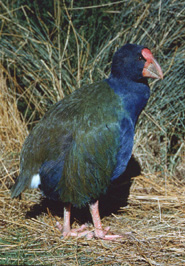
|
|
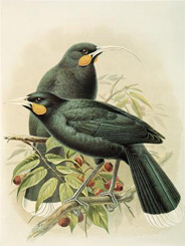
|
|
 |
|
 |
|
| |

|
|
| |
|
| |
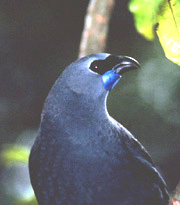 |
|
 |
|
|
|
|
|
 |
|
|
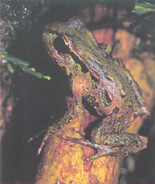 |
|
| |

Kiwi population shrinking
"Fewer than 15 North Island brown kiwi are thought to be surviving in western Bay
of Plenty, sparking fresh fears for the survival ... will be extinct there within four
years unless action is taken"
New Zealand Herald
20 December 2004
New Zealand's flight path to disaster
"Few people are aware that, as the authors claim, New Zealand has a better
record of the birds that lived over the past 100,000 years than any other area
of the world. Our avifauna is diverse, unique, special, intriguing - and, to a
large extent, extinct"
New Zealand Herald
14 January 2003
UN alert on threat to birds
"The UN document, the bi-annual Environment Programme (UNEP) GEO-3 report,
estimates a quarter of the world's mammal species and 12 per cent of birds -
including 15 per cent of New Zealand species - face extinction over the
next 30 years ..."
New Zealand Herald
23 May 2002
Kiwi an Aussie who overstayed
"The kiwi, New Zealand's national bird and sports symbol, probably originated
in Australia, says a New Zealand scientist. Molecular evolutionist Dr Alan Cooper
led an Oxford University team that found the kiwi developed in Australia and
migrated to NZ about 70 million years ago along the Norfolk Ridge, or Lord Howe
Rise, that linked the two countries ..."
New Zealand Herald
8 February 2001
|
|
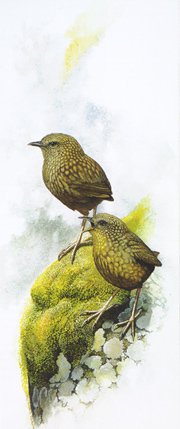
 |
|
 
The value of conservation is better understood by an appreciation of lost biodiversity.
New Zealand's greatest biological loss is 42 percent of its' terrestrial birds since human
settlement 700 years ago. The 57 extinct birds evolved in an isolated land, and without
mammal predators, developed various levels of flightlessness, ground feeding and nesting
habits, and fearlessness over millions of years.
The first 38 extinctions during human settlement were influenced by Maori hunting
for food, indiscriminate forest burning, and introduction of the Polynesian rat and dogs.
Since mid-1800 European arrival there have been another 19 losses caused by logging, forest
clearing for pasture, and introduction of a hoard of predatory animals including bird enemies
numbers one and two, stoats and rats. The prominent extinction groups are all 14 moas,
11 rails, 6 wrens and both eagles.
Image above: Skull of Haast's eagle |
The huia was probably the greatest loss to New Zealand's unique avifauna. It became extinct
in 1907 after extensive hunting for collections and its tail feathers, which were in great
demand due to an international fashion of wearing them in hats. The male and female were
so sexually dimorphic with different straight and curved beak forms, they were at first
thought to be separate species.
 See more
See more |
 |
|
Four species of New Zealand wren including three bush wren subspecies, are extinct.
Pachyplichas yaldwyni and P. jagmi are only identified from fossils (1988).
In 1894 a lighthouse keepers cat ate the last Stephens Island wren, the world's smallest and only
flightless songbird. The North Is. bush wren was last seen in 1955, and the South Is.
subspecies in 1972. Stead's bush wren was wiped out by rats on three islands off Stewart
Island in 1964.
 See more See more |
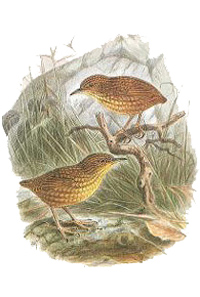 |
|
The takahe is the largest living member of the rail family. Takahe
were hunted until they were rarely found in the 19th century. None were seen after 1900 and
two species were declared extinct, but amazingly, 200 pairs of the South Island species
Porphyrio mantelli (right) were found in a remote region of Fiordland in 1948.
The North Island takahe is extinct, but about 220 of P. mantelli continue their dramatic
brink of extinction existence.
 See more See more
 Hear the call of takahe
[needs RealPlayer to run]
INSTALL REALPLAYER Hear the call of takahe
[needs RealPlayer to run]
INSTALL REALPLAYER |
 |
|
Second only in weight to the extinct elephant bird of
Madagascar, the largest moa was the tallest bird on earth, with the top of its' back
6 feet above the ground. Moa were dominant herbivores in an environment
dominated by birds. Its only predator was Haast's eagle. Fourteen species of moa
were hunted to extinction over a period of 100 years during the 13th and 14th
centuries, immediately after the first human settlement of New Zealand. It
was the fastest known extermination in the world of a whole fauna of large animals.
Moa were in decline when human hunting started, with only 159,000 birds - a severe
reduction from 3 to 12 million thousands of years before the arrival of humans.
 See more
See more |
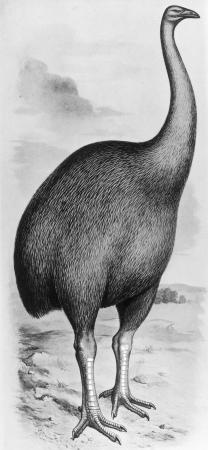 |
Haast's Eagle (Harpagornis)
Harpagornis moorei
Haast's eagle was the world's largest eagle with a wingspan of 3m. It was the only animal
predator of moa, diving on them at a speed of 80 kph and crushing and piercing the moa's
neck with talons the size of tiger's claws. Eagle bones were found in Maori middens,
and it died out with extinction of moa. |
|
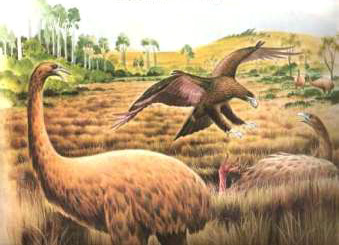 |
|
In the early 1900s, South Island kokako (right, top) were abundant on the main island and Stewart Island.
It has not been seen since the late 1960s and is considered extinct. A search in 2000 in eight areas from the Nelson Lakes to Stewart Island was unsuccessful, but believers think it is out there in some secluded place. The southern subspecies looks almost identical to the North Island kokako (right, bottom), except that it has yellow or orange wattles instead of blue.
 See more
See more |
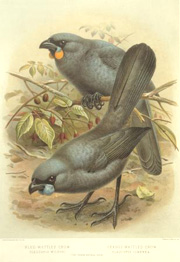 |
North Island piopio Turnagra tanagra
South Island piopio Turnagra capensis
Two species of piopio, also known as the New Zealand thrush, were very tame, endemic,
arboreal island forest omnivores. The South Is. piopio was last seen at Lake Hauroko
and Caswell Sound in 1947, and was declared extinct in 1963. The last North Is. species
was observed in 1949 at Te Aurora, Wanganui. Sir Walter Buller described piopio as
unquestionably New Zealand's best songbird, a title bestowed on kokako today.
 View larger image View larger image |
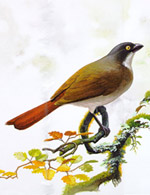 |
New Zealand pelican
Pelecanus novaezelandiae
Pelican bones indicate it weighed 12kg, which is close to today's heaviest flying bird,
the trumpeter swan Cygnus cygnus. It was much larger than its existing Australian
relative. Subfossils from Lake Poukawa are of a bird that lived 3,500
to 4,500 years ago. Bones found at Karikari, Northland; Motutapu Island, Auckland; Lake
Waikaremoana, Rotorua; and Lake Grassmere, Marlborough show that pelican probably lived
after humans arrived. |
 |
|
The endemic laughing owl was found throughout the country in the mid-1800s before it went
into decline, and was declared extinct in 1914 after the last specimen was found in
Canterbury. Various alleged sightings, the most recent in the 1940s near Opotiki have not
been verified. Whekau had similar red-brown coloring to the morepork which is New
Zealand's only remaining owl, but had a white face and were larger.
 See more See more |
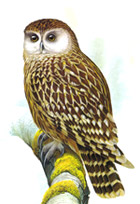 |
Chatham rail Gallirallus modestus
Gallirallus dieffenbachii
About 26 specimens of the "modest" rail remain in museums, collected from its
discovery in 1871 to extinction in 1900.
G. modestus and G. dieffenbachii, co-existed on at least three islands in
the Chatham group, descending from G. philippensis which had dispersed throughout
the Pacific. The two diverged from their volant ancestor, becoming flightless but
with G. dieffenbachii growing larger, and G. modestus smaller to the size
of a blackbird, with a long specialised feeding bill.
 View larger image View larger image |
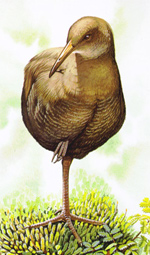 |
Chatham Island fernbird
Bowdleria rufescens
Little was learned about the Chatham Island fernbird which was the size of a house sparrow. The first bird discovered in 1868 was killed by a stone thrower. It was only on Pitt and Mangere Islands in the Chatham group. The last specimen was shot for Lord Walter Rothchild's collection in about 1900. B. rufescens was related to the five weak flying B. punctata subspecies on both mainland islands, Stewart and Codfish
Islands, and subantarctic Snares Island.
 View larger image View larger image |
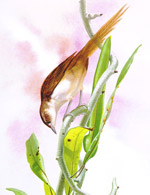 |
New Zealand quail
Coturnix novaezelandiae
The native quail became extinct in about 1875, after a very rapid decline resulting from
extensive shooting for sport and food by European settlers, and the burning of their lowland
tussock habitat. In the 1840s, hunters claimed to have killed 20 to 40 birds in one
day. Quail were very abundant in open country throughout New Zealand, in particular the
grassy Murimotu Plains in the Taupo area, and the downs of the South Island. |

|
|
Merganser were first seen by explorer Jules d'Urville during his 1840 subantarctic voyage. Bones have been identified from South Island and Stewart Island coastal dunes and Maori middens. After extinction on the mainland, it survived on the bleak but beautiful Auckland Islands. The population declined after pigs were introduced to the islands in 1807, and cats in 1820. Since 1840, 26 were killed for collections before the last known pair were shot in 1902 by the Earl of Ranfurly, Governor of New Zealand.
 See more See more |
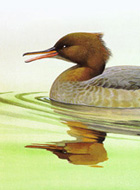 |
|
In 2011, paleontologists reconstructed from fossilised bones, the skeleton of an extinct giant Kairuku penguin. The prehistoric penguins from the Eocene-Oligocene 24 million years ago are only known from New Zealand, and are one of the largest known penguin species. They stood 1.3 metres tall, and weighed at least 60 kilograms. Kairuku were 30cm taller, and 50 percent heavier than the Emperor penguin Aptenodytes forsteri of Antarctica, the largest living penguin species.
 See more See more |
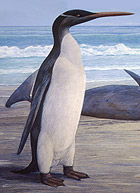 |
| |
 |
| |
|
Other recent extinctions since mid-19th century European settlement
Dieffenbach's rail
Gallirallus dieffenbachii
Stewart Island snipe
Coenocorypha aucklandica iredalei
Little Barrier snipe
Coenocorypha aucklandica barrierensis
Chatham Island bellbird
Anthornis melanocephala
New Zealand little bittern
Ixobrychus novaezelandiae
Additional 20 extinctions since 14th century Maori settlement
North Island adzebill
Aptornis otidfornis
South Island adzebill
Aptornis defosser
Eyles' harrier
Circus eylesi
Chatham Island sea-eagle
Haliaeetus australis
Giant Chatham Island rail
Diaphorapteryx hawkinsi
Hodgen's rail
Gallinula hodgeni
Snipe-rail
Capellirallus karamu
New Zealand coot
Fulica chathamensis
Giant Chatham Island snipe
Coenocorypha chathamica
Hakawai (New Zealand snipe)
Coenocorypha aucklandica
New Zealand owlet-nightjar
Aegotheles novaezealandiae
New Zealand crow
Palaeocorax moriorum
De Lautour's duck
Biziura delautouri
Chatham Island duck
Pachyanas chathamica
Scarlett's duck
Malacorhynchus scarletti
Finsch's duck
Chenonetta finschi
Blue-billed duck
Oxyura australis
North Island goose
Cnemiornis gracilis
South Island goose
Cnemiornis calcitrans
New Zealand swan
Cygnus sumnerensis
Additional 16 extinctions before human settlement
Albatross (unnamed)
Manu antiquus
Narrow flippered penguin
Palaeeudyptes antarcticus
Marples' penguin
Palaeeudyptes marplesi
New Zealand giant penguin
Pachydyptes ponderosus
Wide-flippered penguin
Platydyptes novaezealandiae
Amies' penguin
Platydyptes amiesi
Lowe's penguin
Archaeospheniscus lowei
Lopdell's penguin
Archaeospheniscus lopdelli
Duntroon penguin
Duntroonornis parvus
Oliver's penguin
Korora oliveri
Harris' penguin
Marplesornis novaezealandiae
Moisley's penguin
Tereingaornis moisleyi
Ridgen's penguin
Aptenodytes ridgeni
Tyree's penguin
Pygoscelis tyreei
Miocene false-toothed pelican
Pelagornis miocaenus
Stirton's false-toothed pelican
Pseudodontornis stirtoni
| |
| |
| |
|
Illustration Credit
Center 7th from top:
Piopio
Center 9th from top:
Laughing owl
Center 10th from top:
Chatham rail
Center 11th from top:
Chatham Island fernbird
Center bottom:
Auckland Island merganser
Left bottom: Stephens Island wren
Permission of Peter Schouten
Center top: John Gerrard Keulemans 1842-1912,
Huia (male and female)
Heteralocha acutirostris 1888
Center 4th from top:
Frederick William Frohawk 1861-1942,
Dinornis ingens 1906.
Center 6th from top:
John Gerrard Keulemans 1842-1912, Blue-wattled crow
Glaucopis wilsoni, Orange-wattled crow Glaucopis cinerea 1888
Permission of the Alexander Turnbull Library, Wellington, New Zealand must be obtained
before any re-use of these images.
Photo Credit
Center 3rd from top and left top: Takahe
Right top: Kakapo
Left 3rd from top:
Kokako
Left 4th from top: Tusked weta
Left 5th from top: Archey's frog
Crown Copyright © Department of Conservation
Left 6th from top: Giant kauri, Alexander Turnbull Library |
| |
| |
| |
 |
|



